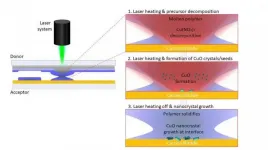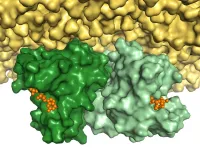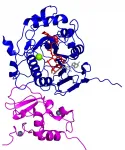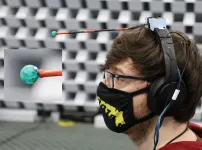Gut to brain: Nerve cells detect what we eat
Nerve cells of the vagus nerve fulfil opposing tasks
2021-06-02
(Press-News.org) The gut and the brain communicate with each other in order to adapt satiety and blood sugar levels during food consumption. The vagus nerve is an important communicator between these two organs. Researchers from the Max Planck Institute for Metabolism Research in Cologne, the Cluster of Excellence for Ageing Research CECAD at the University of Cologne and the University Hospital Cologne now took a closer look at the functions of the different nerve cells in the control centre of the vagus nerve, and discovered something very surprising: although the nerve cells are located in the same control center, they innervate different regions of the gut and also differentially control satiety and blood sugar levels. This discovery could play an important role in the development of future therapeutic strategies against obesity and diabetes.
When we consume food, information about the ingested food is transmitted from the gastrointestinal tract to the brain in order to adapt feelings of hunger and satiety. Based on this information, the brain decides, for example, whether we continue or stop eating. In addition, our blood sugar level are adapted by the brain. The vagus nerve, which extends from the brain all the way down to the gastrointestinal tract, plays an essential role in this communication. In the control center of the vagus nerve, the so-called nodose ganglion, various nerve cells are situated, some of which innervate the stomach while others innervate the intestine. Some of these nerve cells detect mechanical stimuli in the different organs, such as stomach stretch during feeding, while others detect chemical signals, such as nutrients from the food that we consume. But what roles these different nerve cells play in transmitting information from the gut to the brain, and how their activity contributes to adaptations of feeding behavior and blood sugar levels had remained largely unclear.
"To investigate the function of the nerve cells in the nodose ganglion, we developed a genetic approach that enables us to visualize the different nerve cells and manipulate their activity in mice. This allowed us to analyze which nerve cells innervate which organ, pointing to what kind of signals they detect in the gut," says study leader Henning Fenselau. "It also allowed us to specifically switch on and off the different types of nerve cells to analyze their precise function."
Different food activates different nerve cells
In their studies, the researchers focused primarily on two types of nerve cells of the nodose ganglion, which is just one millimeter in size. "One of these cell types detects stomach stretch, and activation of these nerve cells causes mice to eat significantly less," Fenselau explains. "We identified that activity of these nerve cells is key for transmitting appetite-inhibiting signals to the brain and also decreasing blood sugar levels." The second group of nerve cells primarily innervates the intestine. "This group of nerve cells senses chemical signals from our food. However, their activity is not necessary for feeding regulation. Instead, activation of these cells increases our blood sugar level," says Fenselau. Thus, these two types of nerve cells in the control center of the vagus nerve fulfil very different functions.
"The reaction of our brain during food consumption is probably an interplay of these two nerve cell types," Fenselau explains. "Food with a lot of volume stretches our stomach, and activates the nerve cell types innervating this organ. At a certain point, their activation promotes satiety and hence halts further food intake, and at the same time coordinates the adaptations of blood sugar levels. Food with a high nutrient density tends to activate the nerve cells in the intestine. Their activation increases blood glucose levels by coordinating the release of the body's own glucose, but they do not halt further food intake." The discovery of the different functions of these two types of nerve cells could play a crucial role in developing new therapeutic strategies against obesity and diabetes.
INFORMATION:
Original publication
Diba Borgmann, Elisa Ciglieri, Nasim Biglari, Claus Brandt, Anna Lena Cremer, Heiko Backes, Marc Tittgemeyer, F. Thomas Wunderlich, Jens C. Bru?ning, Henning Fenselau
Gut-brain communication by distinct sensory neurons differently controls feeding and glucose metabolism.
Cell Metabolism, 26 May 2021
[Attachments] See images for this press release:
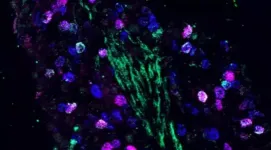
ELSE PRESS RELEASES FROM THIS DATE:
2021-06-02
In the journal Nature Communications, an interdisciplinary team from the Max Planck Institute of Colloids and Interfaces presents for the first time a laser-driven technology that enables them to create nanoparticles such as copper, cobalt and nickel oxides. At the usual printing speed, photoelectrodes are produced in this way, for example, for a wide range of applications such as the generation of green hydrogen.
Previous methods produce such nanomaterials only with high energy input in classical reaction vessels and in many hours. With the laser-driven technology developed at the institute, the scientists can deposit small amounts of material on a surface and simultaneously perform chemical synthesis in a very short time using high temperatures from the laser. 'When I discovered ...
2021-06-02
A facial expression or the sound of a voice can say a lot about a person's emotional state; and how much they reveal depends on the intensity of the feeling. But is it really true that the stronger an emotion, the more intelligible it is? An international research team comprised of scientists from the Max Planck Institute for Empirical Aesthetics, New York University, and the Max Planck NYU Center for Language, Music, and Emotion (CLaME) has now discovered a paradoxical relationship between the intensity of emotional expressions and how they are perceived.
Emotions ...
2021-06-02
Researchers from Bochum and Osnabrück have gained new insights into the structure of the Ras protein, which acts as a molecular switch for cell growth and is involved in the development of cancer. With the help of fluorescence markings, they have demonstrated that the protein is deposited in a pair at the cell membrane, and with the very structure that they predicted in theory back in 2012. The team from the Bochum Center for Protein Diagnostics (PRODI) hopes that these findings will open up a new approach for the development of cancer medications. The researchers from Ruhr-Universität Bochum (RUB) and Osnabrück University ...
2021-06-02
Prenuptial agreements, or "prenups," can be difficult to talk about. But a recent study offers insights into how people can discuss this often taboo subject. One approach? Use metaphors.
"Many people view prenups as being negative, and argue that they indicate a lack of faith in the marriage from the outset," says Lynsey Romo, corresponding author of the study and an associate professor of communication at North Carolina State University. "By the same token, we know from other research that open communication about financial issues contributes to successful relationships.
"And yet there is virtually no academic research on prenups. So how do people talk about prenups? How do they make sense of them? That's what we wanted ...
2021-06-02
SAN ANTONIO (June 2, 2021) -- Scientists from The University of Texas Health Science Center at San Antonio have discovered a mechanism by which SARS-CoV-2 exploits changes in metal ion concentrations to disguise itself in the body. Varying concentrations of metal ions -- positively charged atoms such as magnesium, manganese and calcium -- are observed in hospitalized COVID-19 patients.
"This is a newly described metal-dependent mechanism by which these ions help the virus to evade immune surveillance," said END ...
2021-06-02
RUDN University chemists proposed a new way to synthesize catalysts for the conversion of ethyl alcohol. The obtained materials are promising catalysts for the selective conversion of ethanol, which is an important stage in the development of an alternative technology for obtaining valuable chemical synthesis products based on plant raw materials. The results of the study are published in Catalysis Today.
Ethanol fuel is ethyl alcohol, it is produced from plant material by fermentation of industrial or agricultural waste biomass. It is used as a more environmentally ...
2021-06-02
In collaborative international effort, laser physicists at LMU have built the first hybrid plasma accelerator.
Particle accelerators have made crucial contributions to some of the most spectacular scientific discoveries of modern times, and greatly augmented our knowledge of the structure of matter. Now a team of laser physicists led by Prof. Stefan Karsch at the Ludwig-Maximilian University (LMU) in Munich and the Max Planck Institute for Quantum Optics, in cooperation with scientists based at the Helmholtz Centre in Dresden-Rossendorf (HZDR), the Laboratoire d'Optique Appliquée in Paris (LOA), Strathclyde University in Glasgow and the DESY Electron Synchrotron in Hamburg, have now achieved a significant ...
2021-06-02
Amsterdam, June 2, 2021 - On the eve of the 50th anniversary of the 1972 Stockholm conference that created the United Nations Environmental Programme, it is clear that the global environmental situation has only deteriorated. In "Our Earth Matters: Pathways to a Better Common Environmental Future," an extended special issue of Environmental Policy and Law (EPL), leading scholars from more than five continents call for an honest introspection of what has been attained over the last 50 years relating to regulatory processes and laws and explore future trajectories with new ideas and frameworks for environmental governance in the 21st century.
"Our objective is to fire the imaginations of scholars and decision-makers to re-examine current approaches and to explore the future, ...
2021-06-02
Smoking in early puberty in boys may have negative consequences for their future generations of offspring, a study from the University of Bergen (UiB) shows.
By continued analysis of data gathered in the large international RHINESSA, RHINE and ECRHS studies, researchers have found that the health of future generations depends on actions and decisions made by young people today. This is particularly relevant for boys in early puberty and mothers/grandmothers both pre-pregnancy and during pregnancy, the study shows.
The paper "Prenatal and prepubertal exposures to tobacco smoke in ...
2021-06-02
Humans can observe what and where something happens around them with their hearing, as long as sound frequencies lie between 20 Hz and 20 000 Hz. Researchers at Aalto University have now developed a new audio technique that enables people to also hear ultrasonic sources that generate sound at frequencies above 20,000 Hz with simultaneous perception of their direction. The results have been published in Scientific Reports on 2 June 2021.
'In our study, we used bats in their natural habitat as sources of ultrasonic sound. With our new technique, we can now hear the directions-of-arrival of bat sounds, which means we can track bats in flight and hear where they are - we're ...
LAST 30 PRESS RELEASES:
[Press-News.org] Gut to brain: Nerve cells detect what we eat
Nerve cells of the vagus nerve fulfil opposing tasks

